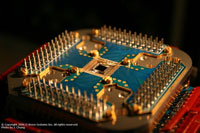 | | A view of a 16-qubit processor mounted in its sample holder |
|
As promised, Canadian firm
D-Wave Systems unveiled and demonstrated today what it calls "the world's
first commercially viable quantum computer." Company officials announced the
technology at the Computer History Museum in Mountain View, California in a
demonstration intended to show how the machine can run commercial applications
and is better suited to the types of problems that have stymied conventional
(digital) computers. The demonstration of the technology was held at the
Computer History Museum, but the actual hardware remained in Burnaby, BC where
it was being chilled down to 5 millikelvin, or minus 273.145 degrees Celsius
(colder than interstellar space), with liquid helium.
Quantum computers rely on quantum mechanics, the rules that underlie the
behavior of all matter and energy, to accelerate computation. It has been known
for some time that once some simple features of quantum mechanics are harnessed,
machines will be built capable of outperforming any conceivable conventional
supercomputer. But D-Wave explains that its new device is intended as a
complement to conventional computers, to augment existing machines and their
market, not to replacement them.
To make the technology commercially applicable, D-Wave used the processes and
infrastructure associated with the semiconductor industry. The D-Wave computer,
dubbed Orion, is based on a silicon chip containing 16 quantum bits, or
'qubits,' which are capable of retaining both binary values of zero and one. The
qubits mimic each others' values allowing for an amplification of their
computational power. D-Wave says that its system is scalable by adding multiples
of qubits. The company expects to have 32-qubit systems by the end of this year,
and as many as 1024-qubit systems by the end of 2008.
For more technical information quantum computing, read
D-Wave founder and CTO Geordie Rose's blog.